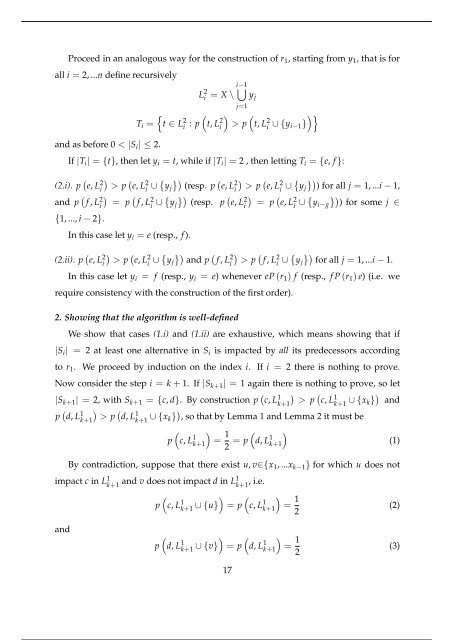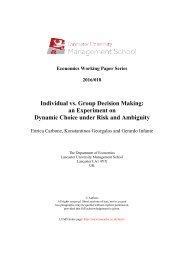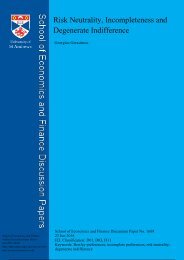Dual Random Utility Maximisation
n?u=RePEc:san:wpecon:1605&r=upt
n?u=RePEc:san:wpecon:1605&r=upt
Create successful ePaper yourself
Turn your PDF publications into a flip-book with our unique Google optimized e-Paper software.
Proceed in an analogous way for the construction of r 1 , starting from y 1 , that is for<br />
all i = 2, ...n define recursively<br />
T i =<br />
and as before 0 < |S i | ≤ 2.<br />
L 2 i = X \<br />
i−1 ⋃<br />
j=1<br />
{ ( )<br />
t ∈ L 2 i : p t, L 2 i > p<br />
y j<br />
(<br />
)}<br />
t, L 2 i ∪ {y i−1}<br />
If |T i | = {t}, then let y i = t, while if |T i | = 2 , then letting T i = {e, f }:<br />
(2.i). p ( e, L 2 i<br />
) > p<br />
(<br />
e, L<br />
2<br />
i<br />
∪ { y j<br />
})<br />
(resp. p<br />
(<br />
e, L<br />
2<br />
i<br />
) > p<br />
(<br />
e, L<br />
2<br />
i<br />
∪ { y j<br />
})<br />
) for all j = 1, ...i − 1,<br />
and p ( f , L 2 i<br />
) = p<br />
(<br />
f , L<br />
2<br />
i<br />
∪ { y j<br />
})<br />
(resp. p<br />
(<br />
e, L<br />
2<br />
i<br />
) = p<br />
(<br />
e, L<br />
2<br />
i<br />
∪ { y i−g<br />
})<br />
) for some j ∈<br />
{1, ..., i − 2}.<br />
In this case let y i = e (resp., f ).<br />
(2.ii). p ( e, L 2 i<br />
) > p<br />
(<br />
e, L<br />
2<br />
i<br />
∪ { y j<br />
})<br />
and p<br />
(<br />
f , L<br />
2<br />
i<br />
) > p<br />
(<br />
f , L<br />
2<br />
i<br />
∪ { y j<br />
})<br />
for all j = 1, ...i − 1.<br />
In this case let y i = f (resp., y i = e) whenever eP (r 1 ) f (resp., f P (r 1 ) e) (i.e. we<br />
require consistency with the construction of the first order).<br />
2. Showing that the algorithm is well-defined<br />
We show that cases (1.i) and (1.ii) are exhaustive, which means showing that if<br />
|S i | = 2 at least one alternative in S i is impacted by all its predecessors according<br />
to r 1 . We proceed by induction on the index i. If i = 2 there is nothing to prove.<br />
Now consider the step i = k + 1. If |S k+1 | = 1 again there is nothing to prove, so let<br />
|S k+1 | = 2, with S k+1 = {c, d}. By construction p ( c, L 1 k+1) > p<br />
(<br />
c, L<br />
1<br />
k+1<br />
∪ {x k } ) and<br />
p ( d, L 1 k+1) > p<br />
(<br />
d, L<br />
1<br />
k+1<br />
∪ {x k } ) , so that by Lemma 1 and Lemma 2 it must be<br />
( )<br />
p c, L 1 k+1 = 1 ( )<br />
2 = p d, L 1 k+1<br />
By contradiction, suppose that there exist u, v∈{x 1 , ...x k−1 } for which u does not<br />
impact c in L 1 k+1 and v does not impact d in L1 k+1 , i.e.<br />
) ( )<br />
p<br />
(c, L 1 k+1 ∪ {u} = p c, L 1 k+1 = 1 2<br />
(1)<br />
(2)<br />
and<br />
) ( )<br />
p<br />
(d, L 1 k+1 ∪ {v} = p d, L 1 k+1 = 1 2<br />
(3)<br />
17






